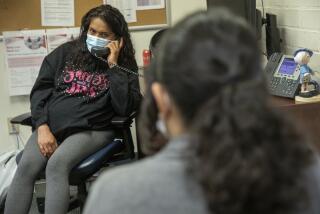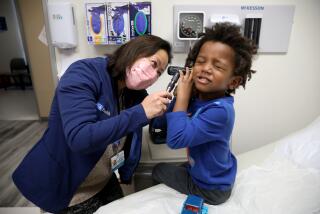How insurance gaps affect youths
- Share via
For every child who lacks health insurance, another has gaps in coverage and is just as likely to miss out on seeing a doctor or getting a prescription refilled, suggests a new comprehensive study of federal data.
The research also reveals some surprises: About four out of five children with insurance coverage gaps have parents who work; two-thirds of them live with both parents; and more than half are white.
At least 9 million U.S. children, or about 12%, lack health insurance, based on a federal survey in 2003.
Researchers who produced the latest study say that number is likely higher because many kids who lack health insurance during part of their childhood aren’t included in that number.
“There is an oversimplified view of what is uninsured,” said Lynn Olson of the American Academy of Pediatrics, who led the study. “We should be measuring who is uninsured in multiple ways in order to understand what the true burden is.”
Many studies have documented the health barriers faced by uninsured children, such as missing regular checkups and visiting hospital emergency rooms for routine care. But this is one of the few analyses of what happens to children when their families have intermittent coverage.
“It really calls attention to an important group of children we often don’t consider,” said Dr. Glenn Flores, director of the Center for the Advancement of Underserved Children at the Medical College of Wisconsin, who was not connected to the research.
Marian Blackmon, a telephone operator in Jackson, Miss., said that when her husband retired last year, her three sons were dropped from his health plan. Blackmon recalled how she avoided taking one of her 6-year-old twins to the pediatrician when he became feverish because she did not want to pay out-of-pocket for the visit.
But when 12-year-old Nicholas fell off a horse last year and was rushed to the emergency room, Blackmon had no choice but to pay the medical bill.
“It’s very stressful,” said the 43-year-old mother, who recently applied to enroll her kids in a public health insurance program for low-income children.
The researchers analyzed data from a national health survey in 2000 and 2001. They estimated that almost 7% of children were uninsured, but another 8% lacked coverage for part of the year. The researchers found that the children with intermittent coverage were more likely to postpone medical care than uninsured kids.
For example, 20% of children who were uninsured for part of the year delayed getting medical attention because parents worried about cost compared with 16% without insurance and 4% with public and private coverage.
Results appear in last week’s New England Journal of Medicine. Among the study’s findings:
* About 58% of children with coverage gaps were white, while 46% of those with no insurance were Hispanic.
* Eighty-two percent of kids with coverage gaps lived with at least one working parent, and 61% lived with both parents.
* A third were in preschool, an age when children typically get immunized.
* Thirteen percent of children who were insured only part of the time missed doctor appointments and one in 10 did not get prescriptions refilled because of the cost -- percentages virtually equal to those for uninsured children.






